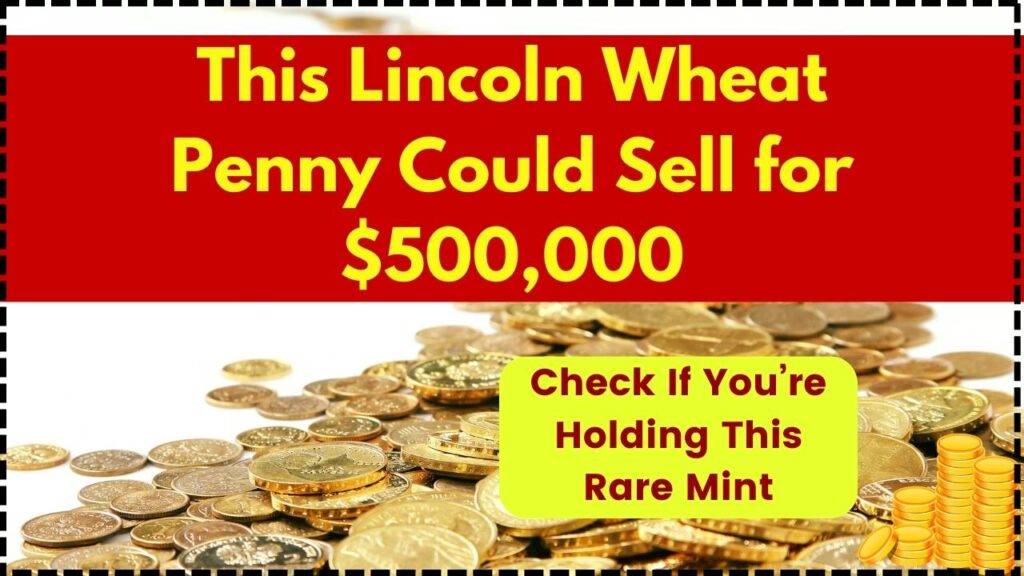This Lincoln Wheat Penny Could Sell for $500,000: If you’ve ever spotted an old penny with wheat stalks on the back, you might want to pause before tossing it in the coin jar. That little piece of copper could be worth more than your entire wallet. One particular Lincoln Wheat Penny — the rare 1943 copper version — has sold for over $500,000, and some experts believe it could fetch even more. In this article, we’ll walk you through what makes this penny so valuable, how to identify it, and what to do if you think you’ve struck gold. Whether you’re just starting out or you’re a seasoned coin collector, this guide will help you make sense of it all — in plain English, backed by facts, and easy enough for a 10-year-old to understand.
This Lincoln Wheat Penny Could Sell for $500,000
The 1943 Copper Lincoln Wheat Penny is more than a coin — it’s a piece of American history that could be worth a small fortune. With only a few dozen confirmed to exist, it’s like winning the numismatic lottery if you find one. But even if you don’t, coin collecting is a fun, educational hobby that teaches history, patience, and the value of looking closely. Check your change, learn the basics, and you might just discover a treasure hiding in plain sight.

| Topic | Details |
|---|---|
| Valuable Coin | 1943 Copper Lincoln Wheat Penny |
| Potential Value | Up to $500,000+ |
| Why It’s Rare | Minted in copper during WWII when pennies were supposed to be steel |
| Other Rare Pennies | 1909-S VDB, 1955 Doubled Die, 1944 Steel |
| Authentication Tools | Magnet test, weight check, professional grading |
| Trusted Grading Services | PCGS, NGC |
| Best Selling Platforms | Heritage Auctions, eBay (with caution), GreatCollections |
| IRS Reporting Threshold | Over $600 in gains (consult tax advisor) |
A Brief History of the Lincoln Wheat Penny
The Lincoln Wheat Penny was first issued in 1909 to commemorate the 100th birthday of President Abraham Lincoln. It was the first U.S. coin to feature a real person instead of a symbolic figure. The reverse design had two simple wheat ears, representing prosperity and agricultural heritage. These coins were minted from 1909 to 1958, after which the wheat was replaced by the Lincoln Memorial design.
Among the hundreds of millions produced, a handful became rare due to minting errors, limited production, or historical circumstances. The most famous of them all is the 1943 copper penny, which resulted from a mistake during wartime.
Why This Lincoln Wheat Penny Could Sell for $500,000?
During World War II, the U.S. Mint needed copper for the war effort — think bullets, wire, and other military supplies. So in 1943, they switched penny production to zinc-coated steel. However, a few leftover copper blanks (called planchets) from 1942 were mistakenly fed into the presses.
The result? A 1943 penny made from copper instead of steel, which wasn’t supposed to exist. Today, only about 30 to 40 genuine examples have been confirmed, making them ultra-rare and highly valuable to collectors.
One specimen even sold for $1.7 million in 2010 (Heritage Auctions). Depending on condition, provenance, and certification, others have fetched between $250,000 and $500,000.
How to Identify This Lincoln Wheat Penny Could Sell for $500,000?
Here’s a checklist to help you determine if your penny could be one of the valuable ones:
1. Check the Date
You’re looking for a penny dated 1943. That’s your starting point.
2. Use a Magnet
Steel is magnetic, but copper isn’t. If your 1943 penny sticks to a magnet, it’s not the rare one.
3. Weigh the Coin
Use a precise digital scale:
- A steel penny weighs around 2.7 grams
- A copper penny weighs about 3.11 grams
4. Inspect the Color
Steel pennies often look silver and may have rust. Copper pennies are brown or reddish, and they don’t rust.
5. Professional Grading
If your coin passes the magnet and weight tests, it’s time to send it to a grading service like:
- PCGS (Professional Coin Grading Service)
- NGC (Numismatic Guaranty Company)
They’ll confirm if it’s genuine and assign it a grade, which greatly affects its value.
Other Rare and Valuable Lincoln Wheat Pennies
Even if your 1943 penny turns out to be steel, don’t worry. Here are a few other high-value Lincoln Wheat Pennies to look for:
| Coin | Value | Why It’s Rare |
|---|---|---|
| 1909-S VDB | $300,000+ | Only 484,000 minted with VDB initials; first-year issue |
| 1955 Doubled Die | $10,000–$120,000 | Clear doubling on “LIBERTY” and “IN GOD WE TRUST” |
| 1944 Steel | Up to $500,000 | Minted on leftover steel planchets by mistake |
| 1958 Doubled Die | $200,000+ | Extremely limited mintage with doubling on front text |
Tips for Beginners: How to Start Collecting Coins
If this whole thing sparked your interest, here are a few easy ways to dip your toes into coin collecting:
- Start by going through your pocket change. You’d be surprised what you’ll find.
- Visit local coin shops or collector shows to learn from experienced collectors.
- Download coin-tracking apps like CoinSnap or use online databases.
- Invest in a coin album or folders to organize what you find.
- Join online communities like CoinTalk or Reddit’s r/coins.
How to Sell a Rare Penny Safely?
If you think you’ve found something valuable, don’t sell it at a pawn shop or throw it on eBay without research. Here’s a safer approach:
- Get it Graded – Use PCGS or NGC for certification.
- Consider Auction Houses – Like Heritage Auctions, which handle high-value coins with expertise.
- Avoid Craigslist – It’s riskier and less regulated.
- Document Everything – Keep all paperwork, grading reports, and appraisals.
- Watch for Scams – If it sounds too good to be true, it probably is.
Taxes: What You Need to Know
Yes, even Uncle Sam wants a piece of the action. If you sell a coin for more than $600, it could be considered a capital gain, and you’ll need to report it on your taxes. Always check with a qualified tax advisor if you’re selling something big.
These Rare Coins Are Worth Millions – Check If Coin Collecting Is Your Next Big Investment Move
Frequently Asked Questions
Are all 1943 pennies valuable?
No. Most are steel and worth 10–50 cents. Only the copper version is rare.
What happens if my penny fails the magnet test but weighs wrong?
You might have a counterfeit. Professional grading is the only way to be sure.
Can I clean my coin before selling?
Never. Cleaning reduces its value. Leave it untouched.
Where can I get my coin looked at locally?
Try certified coin dealers listed by the American Numismatic Association (ANA).





